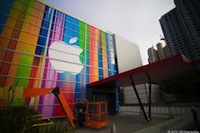Apple's iPhone 5 event: By the numbers

Apple's announcement of the next-generation iPhone didn't just show off the device itself, it was filled with numbers and statistics of the company's progress since it launched the iPad 3 in March.
The new iPhone revealed in San Francisco today is a whole new design with a larger 4-inch screen, an improved A6 processor, global 4G LTE cellular network support, and a smaller 'Lightning'-pin dock connector, just to name a few features. It also comes with the latest iOS 6 mobile operating system, packed with new features such as Maps, Facebook integration, Passbook, and much more.
During the event, Apple executives took to the stage to show off the latest statistics and figures. Here are the latest numbers you need to know:
12 countries with more than 380 Apple stores;
83 million visitors to Apple stores between April--June, more than 1 million people per day;
Six generations of the smartphone have launched since the original iPhone debuted in 2007, despite the "iPhone 5" name;
Seven million downloads of OS X 10.8 Mountain Lion downloaded since its launch July, the fastest selling OS X release so far;
17 million iPads sold between April--June, totalling 84 million iPads sold in total through June;
68 percent in worldwide tablet market share thanks to the iPad;
91 percent of all Web traffic from tablets come from the iPad;
94 percent of all Fortune 500 companies are testing or deploying iPads;
A6 processor is twice as fast as the A5 chip, also twice as fast for graphics.
250,000 apps for the iPad in the iTunes App Store;
100 apps is the per-person average for app owning;
400 million iOS devices sold to date through June;
63 countries where the iTunes Store is available;
453 million iTunes accounts with 1-Click purchasing set-up;
200 million customers using iTunes in the Cloud, downloading 15 billion songs;
Seven generations of the iPod range in total after today;
350 million iPods sold to date, adding "millions every quarter;"
175,000 games and entertainment apps available for the iPod touch;
600 million sets of headphones for the iPhone, iPad, and iPod range.
Only one Foo Fighters who performed at the iPhone launch.
Other numbers to consider from earlier reports:
GDP boost: Sales of the new iPhone could boost the U.S.' gross domestic product (GDP) by $3.2 billion in the fourth-quarter, or $12.8 billion annually, J.P. Morgan chief economist Michael Feroli estimates in a research note seen by the Wall Street Journal.
Initial sales: Topeka Capital analyst Brian White says Apple could sell between 1.3--1.5 million iPhone 5 handsets in the first 24 hours.
First weekend sales: Raymond James director Tavis McCourt told AllThingsD he expects between five to six million iPhone 5 handsets sold during the first weekend. Piper Jaffray analyst Gene Munster says Apple could sell as many as 6--10 million in the first week alone.
Despite a recent record high share price of $682.10 on September 7, at yesterday's market close Apple ended the day down 0.3 percent at $660 a share with a market cap of $619.2 billion.
But throughout the day, Apple remained mostly flat despite the anticipation and generally positive media response. During the announcement, the firm's share price rose to a weekly high of $668 a share, but dipped into the red about the time the Foo Fighters came on stage for an impromptu gig. (I'm not kidding.)
To put Apple's stock price in perspective, Apple brought in four-times more profit during 2012 Q1 than Walmart did during the same quarter. During that quarter, Apple's iPhone brought in more revenue than Microsoft did as an entire company.
The iPhone isn't just a big deal: it's Apple's top priority as a company to get right.
